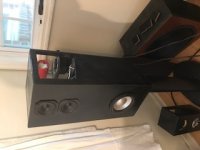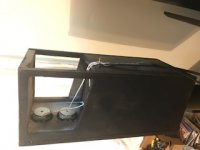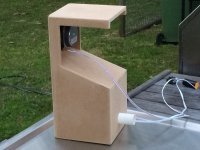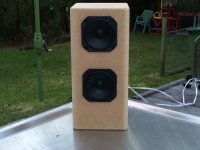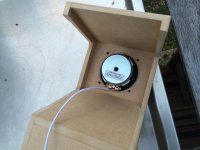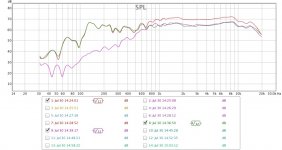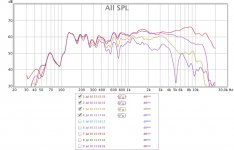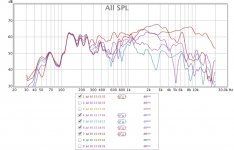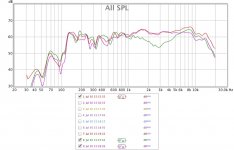I am going to try to add some fuel to this fire. I ran into these recently. The GR Research OB-5. They sell them as a kit. It is the same thing we were discussing in this thread. It uses 2 5.25" in a sealed chamber, and 2 5.25" in an open baffle with a planar ribbon tweeter. They sell the 5.25" drivers for around $28 each. I really like the looks of this design.
OB-5
Has anyone had any success in their build? I am loving my clones.
OB-5
Has anyone had any success in their build? I am loving my clones.
Has anyone made any more progress on their builds? I've been playing around with some Dayton PS95-8's lately and I'm thinking this would be a great application for them. Also trying to figure out a bass reflex system to sit below them and get down to 40hz. Looking to keep the towers nice and slim. Not an easy task it turns out.
I really like the looks of this design.
OB-5
The lower mid of the MTM "sees" a reflective surface on the back.
I hope the designer took some felt and put it in there to eliminate the reflection
Ok. So I have committed to trying something here. I have built a cabinet along the lines of the Nola Micro Gold. It is 22" tall x 9.5" wide and 10" deep. I am using 2 of the Vifa 3.5" on the top and a SEAS Prestige L16RN-SL (H1480) 6" Aluminum Cone Woofer on the bottom.
I have a MiniDSP but it has broken so I am having to experiment with the crossover. I am running the Vifas full range on the top. I am running a 1st order crossover at 200Hz on the Seas. They sound VERY good. They image well and really disappear. I would love to experiment with the crossover. I am not sure which way to go though.
I have a MiniDSP but it has broken so I am having to experiment with the crossover. I am running the Vifas full range on the top. I am running a 1st order crossover at 200Hz on the Seas. They sound VERY good. They image well and really disappear. I would love to experiment with the crossover. I am not sure which way to go though.
Attachments
To do a proper crossover, you'll need a measurement mic and look at the FR curves of both the TC9s and the Seas.
With measurements, you can input them into something like the freeware XSim and come up with your own customised XO.
With measurements, you can input them into something like the freeware XSim and come up with your own customised XO.
Thanks. I have downloaded XSim. I also was able to get my miniDSP working. I am going to try to find a mic and get started.
Very nice! I'm interested in your results ;-)Ok. So I have committed to trying something here. I have built a cabinet along the lines of the Nola Micro Gold. It is 22" tall x 9.5" wide and 10" deep. I am using 2 of the Vifa 3.5" on the top and a SEAS Prestige L16RN-SL (H1480) 6" Aluminum Cone Woofer on the bottom.
I have a MiniDSP but it has broken so I am having to experiment with the crossover. I am running the Vifas full range on the top. I am running a 1st order crossover at 200Hz on the Seas. They sound VERY good. They image well and really disappear. I would love to experiment with the crossover. I am not sure which way to go though.
Hello all.
A couple of questions for those that have built the BT:
Would anyone care to share the IDs for the cabinet used? Or drawings? I believe two different cabinets were modeled earlier in this thread. Curious as to the 20° top to the lower driver's box. Is it to aid the OB (top) or the lower driver? Does the driver spacing (from one another) come into play? I'm assuming the drivers are centered in their respective half of the 12" baffle. Is this correct? Also very curious if anyone has tried this configuration with another small full range. Could a "pico neo" with another ns3 in this configuration work? Possibly allowing for a lower end to be used without a sub.
Did any of you use polyfill or other treatment?
Thanks for your time!
-jake
A couple of questions for those that have built the BT:
Would anyone care to share the IDs for the cabinet used? Or drawings? I believe two different cabinets were modeled earlier in this thread. Curious as to the 20° top to the lower driver's box. Is it to aid the OB (top) or the lower driver? Does the driver spacing (from one another) come into play? I'm assuming the drivers are centered in their respective half of the 12" baffle. Is this correct? Also very curious if anyone has tried this configuration with another small full range. Could a "pico neo" with another ns3 in this configuration work? Possibly allowing for a lower end to be used without a sub.
Did any of you use polyfill or other treatment?
Thanks for your time!
-jake
Jake,
Funny that you should ask these questions. I've just built a pair, using the best information I could extract from this thread, plus other searches on the originals. I can write up the dimensions I used and post them here. I've also done a complete(ish) set of acoustic measurements, and plan to post them here too. Give me a day or so.
Graham.
Funny that you should ask these questions. I've just built a pair, using the best information I could extract from this thread, plus other searches on the originals. I can write up the dimensions I used and post them here. I've also done a complete(ish) set of acoustic measurements, and plan to post them here too. Give me a day or so.
Graham.
Hi Jake,
Here's what I just built, based on dimensions suggested in this thread. 2 x TC9FD-18-08, 9mm (3/8") MDF, the port is from 1" PVC pipe 2" long. I made them without the rear top panel supports so that I could make the cut-outs on the table and band saw, but I plan to add timber rails in later, I think these are needed to support the top panel adequately.
I built 2, and have listened to them for a few days now in all configurations of with/without sub, with/without crossover, with/without DSP EQ, on stands in my main listening area, and on my workbench.
In my opinion they are an intriguing design, and in some configurations have really jumped out as something special, although I've struggled to set them up when I'm happy with the whole package. So far I can get good imaging, or good flat response, or good integration with the sub, but not all at once. I have more to try, but at the moment I'm left feeling that this is not the best way to use 4 x TC9s and a subwoofer.
Dimensions:
Baffle is 5.5" x 12"
Lower enclosure is 4.75" wide, 5 1/8" deep, 5" high at the back, about 6 3/4" high at the front.
The top of the enclosure is at exactly 20 degrees.
Port is 1" ID x 2" long.
Lower driver is at 4 5/8" from the base of the baffle.
Upper driver is at 9 5/8" from the base of the baffle.
I feel that I need to stress that my comments above and measurements are of the geometry and material that I've used, and should not be extended to any other version.
I'll post measurements shortly.
Graham.
Here's what I just built, based on dimensions suggested in this thread. 2 x TC9FD-18-08, 9mm (3/8") MDF, the port is from 1" PVC pipe 2" long. I made them without the rear top panel supports so that I could make the cut-outs on the table and band saw, but I plan to add timber rails in later, I think these are needed to support the top panel adequately.
I built 2, and have listened to them for a few days now in all configurations of with/without sub, with/without crossover, with/without DSP EQ, on stands in my main listening area, and on my workbench.
In my opinion they are an intriguing design, and in some configurations have really jumped out as something special, although I've struggled to set them up when I'm happy with the whole package. So far I can get good imaging, or good flat response, or good integration with the sub, but not all at once. I have more to try, but at the moment I'm left feeling that this is not the best way to use 4 x TC9s and a subwoofer.
Dimensions:
Baffle is 5.5" x 12"
Lower enclosure is 4.75" wide, 5 1/8" deep, 5" high at the back, about 6 3/4" high at the front.
The top of the enclosure is at exactly 20 degrees.
Port is 1" ID x 2" long.
Lower driver is at 4 5/8" from the base of the baffle.
Upper driver is at 9 5/8" from the base of the baffle.
I feel that I need to stress that my comments above and measurements are of the geometry and material that I've used, and should not be extended to any other version.
I'll post measurements shortly.
Graham.
Attachments
Here's some plots from measurements I've taken. The measurements were done with REW, at 1m distance, on the axis mid way between both drivers, 10ms left window, 100ms right window, 1/12 octave smoothing, and a frequency dependent window of 15 cycles (not sure if that overrides the gating I'd entered). For these baseline measurements I used a 25 uF capacitor in series with the top driver - this seems to be the consensus for the crossover. The subwoofer was not on for these measurements.
The first plot is for the drivers on their own (cap in series for the upper driver), then both together in parallel. Pretty much what you'd expect.
The first plot is for the drivers on their own (cap in series for the upper driver), then both together in parallel. Pretty much what you'd expect.
Attachments
Thank you Sir. Great info. I appreciate you taking the time to post these measurements and explain your build. Was there a reason behind the selection of a 25 uf capacitor? I know 20 uf was selected by others here.
Jake
Jake
Trio Brio Clone Plans
Hi,
I am attaching my Trio Brio Clone Plans for 18 mm MDF, adjusted for measured thickness of 17.2 mm.
Jayant
Hello all.
A couple of questions for those that have built the BT:
Would anyone care to share the IDs for the cabinet used? Or drawings? I believe two different cabinets were modeled earlier in this thread. Curious as to the 20° top to the lower driver's box. Is it to aid the OB (top) or the lower driver? Does the driver spacing (from one another) come into play? I'm assuming the drivers are centered in their respective half of the 12" baffle. Is this correct? Also very curious if anyone has tried this configuration with another small full range. Could a "pico neo" with another ns3 in this configuration work? Possibly allowing for a lower end to be used without a sub.
Did any of you use polyfill or other treatment?
Thanks for your time!
-jake
Hi,
I am attaching my Trio Brio Clone Plans for 18 mm MDF, adjusted for measured thickness of 17.2 mm.
Jayant
Attachments
-
speaker back face.PDF67.1 KB · Views: 387
-
separator.PDF54.1 KB · Views: 279
-
speaker top & bottom faces.PDF48.9 KB · Views: 267
-
speaker right face.PDF65.7 KB · Views: 263
-
speaker left face.PDF66.8 KB · Views: 230
-
speaker front face.PDF69.4 KB · Views: 305
-
BRIO - TRIO CLONE ASSEM WITH 17.2 thick SHEET.PDF87.5 KB · Views: 492
Was there a reason behind the selection of a 25 uf capacitor? I know 20 uf was selected by others here.
Jake
Jake,
I'm not sure why I wrote 25uF, it was indeed 20uF - I just checked the actual crossover components that I used.
Graham.
Hi,
I am attaching my Trio Brio Clone Plans for 18 mm MDF, adjusted for measured thickness of 17.2 mm.
Jayant
Thank you Jayant! Did you use any dampening or polyfill? What do you think of your build?
Jake
- Home
- Loudspeakers
- Full Range
- Need help building open baffle/bass reflex hybrid
